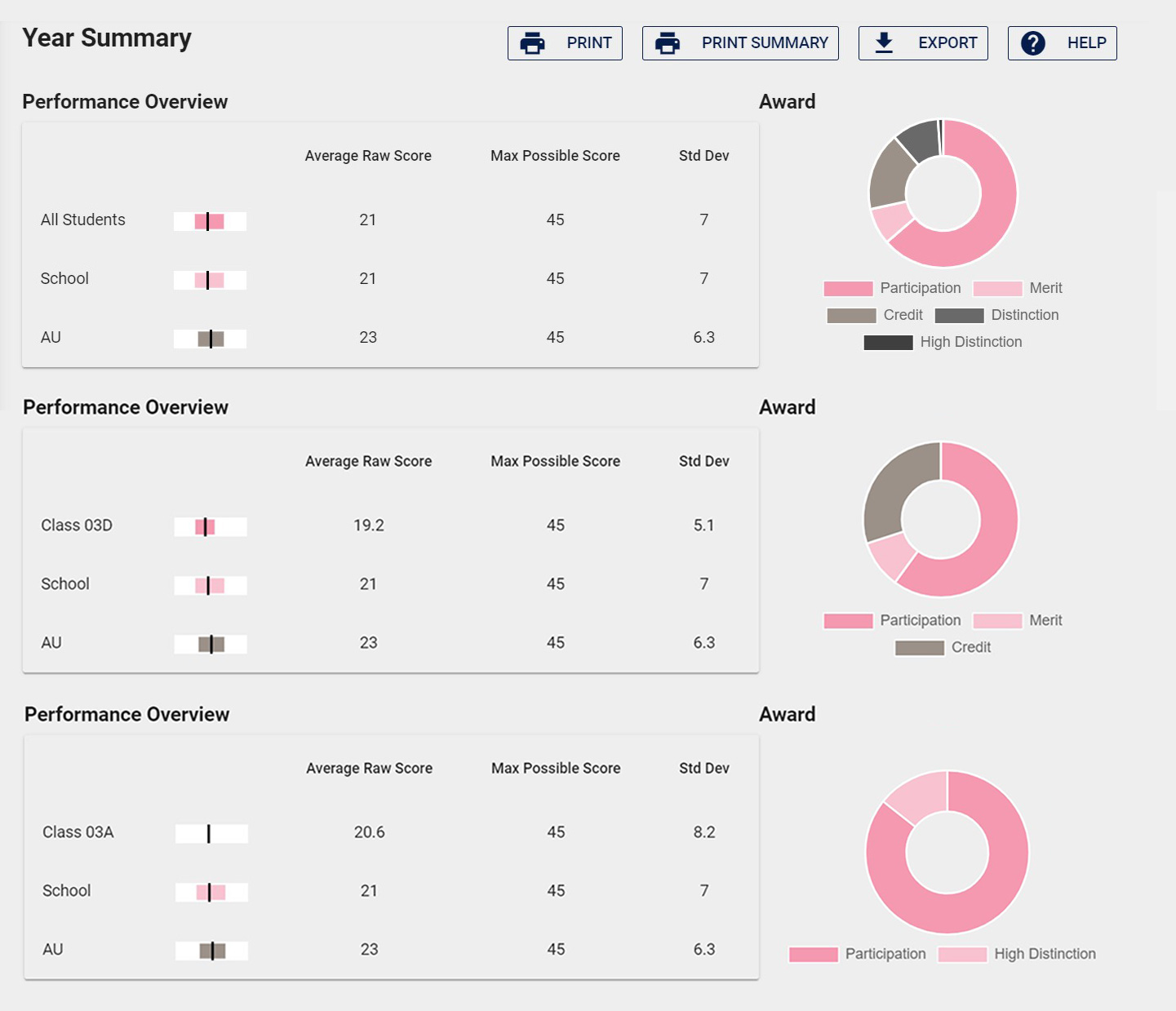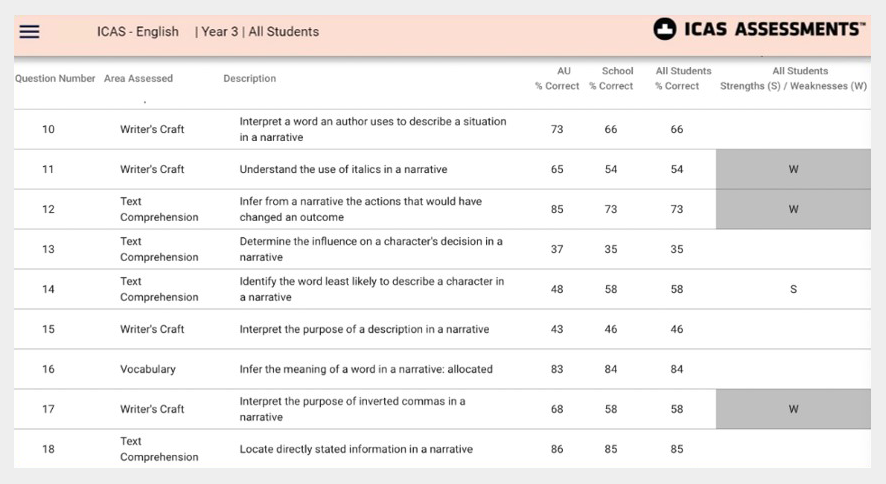10 ways to use ICAS results to boost your school’s performance

On the surface, ICAS is an academic competition that challenges students and recognises their abilities. It tests them across key literacy and STEM subjects and gives them the chance to win rewarding medals. Underneath the surface, it’s so much more.
Far from being an isolated competition that happens in Term 3, ICAS gives educators valuable data that can be used to complement their curriculum in a variety of ways. Its results can help teachers to refine learning programs, be used to promote your school, and most importantly, help to lift the academic performance of every single student.
Here are 10 ways that ICAS results can be used to improve your school’s performance.
1. Place students in the right classes by identifying their skill levels
Thankfully, the “one size fits all” approach to education is long gone. Educators know that there are often a diverse range of skills and needs within a single classroom, and that to teach effectively, they need to be addressed where possible.
While ICAS results are just one piece of the data puzzle, they help by showing your teachers exactly how each student is performing. They are broken down by subject, skill area, and even individual questions. Teachers can see how students fared against their classmates, year level, and the national average, giving them additional informative data that can help them to place students in the right classes. Working alongside the executive team, they can work out whether new support classes or gifted and talented classes are feasible, to provide more effective, inclusive education.

Let’s say a teacher dives into their class’ Maths results for a recent ICAS assessment. They notice a large standard deviation for the subject, which suggests that the class has a wide spread of skill levels, despite their assumption that the students were relatively matched. This information tells them that their class may benefit from being broken up by skill level and taught separately, giving low achievers the support they need to succeed, and high achievers the chance to stretch themselves with advanced topics. This might also be driven by someone in the executive team, who after comparing the performance of cohorts or classes against each other, reaches the same conclusion. In either case, ICAS results allow you to effectively teach students at the very bottom to very top.
2. Identify students’ knowledge gaps and improve learning programs
Teachers can filter ICAS results by skill area for their classes to help identify where their students may be experiencing difficulties. For English, they may discover that particular students are lacking foundational skills required for text comprehension, and suggest extra activities, specific resources or adjusted learning sequences to help fill the gaps. Or their students who sat ICAS Science might be keen observers and measurers of scientific experiments, but average at interpreting the results, which they aim to address with additional teaching. These improvements to their learning programs are backed up by hard data, to be easily justified and validated.

Based on their comparison to the national average, ICAS results are marked with “strength” or “weakness” for specific questions and topics, so that teachers know exactly which content and skill areas need to be addressed and retaught. When triangulated with data from your internal assessments, the insights can become even more useful.

Having this kind of granular data for skill areas really helps your teachers create better learning programs, which can be adapted and refined based on their findings. And if the school has participated in ICAS for a number of years, you can spot trends too, pinpointing which teaching approaches have been successful at advancing certain skill areas, and which failed to hit the mark.
For your reference, these are the skill areas that are assessed as part of each ICAS subject:
| English (Yr 2 – 12) |
Mathematics (Yr 2- 12) |
Science (Yr 2 – 12) |
Digital Technologies |
Writing (Yr 3 – 12) |
Spelling Bee (Yr 2 – 7) |
|
|
|
|
|
|
3. Improve writing programs by accurately comparing skills across year levels
The ICAS Writing assessment uses the same prompts and marking criteria from Year 3 to Year 12. The range of scores available within each criterion makes it incredibly easy to compare writing skills across year levels and identify students whose writing skills are out of step with their peers, as well as where adjustments might be made to your teachers’ writing programs. You can also see where a student has scored in a range that is more typical for a different grade level, such as identifying a Year 4 student who is writing at a Year 6 level. This allows you to support and develop this talent.
By analysing writing results, you’ll learn which year levels are behind, which are on track, and which are excelling, allowing you to shift your strategy where needed and improve this crucial skill. If you have been running ICAS Writing for a number of years, you have the opportunity to track the progress of specific cohorts across calendar years and figure out strategies for further improvements.

4. Use clear data to support report writing, parent teacher interviews and end-of-year student handovers
ICAS results are laid out in an easy-to-use report that can be quickly filtered to find the information you need. When triangulated with data from other assessments, you can see where a student is excelling, where they are hovering around the average, and where they are struggling, all of which provides valuable data for writing student reports, conducting parent teacher interviews and completing end-of-year student handovers. Student reports can be tricky, but with ready data at hand, teachers can justify every recommendation they make to parents. This makes them much more authentic, seeming less like opinions and more like informed advice (because that’s what it is!).
As a former teacher, I know how important it is to work closely with parents on their children’s education. Having clear ICAS results as an additional source of information for parents can help them understand how grades were determined and what may be the best direction for their child.

5. Pinpoint the learning needs of individual students
When looking at ICAS results top-down, it’s easy to forget that year levels, cohorts, and classes are made up of unique students with their own learning styles and skills. But teachers are fully (and sometimes painfully) aware of this, and they know that they need to make their lessons as inclusive as possible to address the varied needs of students in their classes.
To help them do this, they can jump into the ICAS results for their classes, drill down to individual students, and see how they are faring for certain skill areas for each subject. This might be space and geometry for Maths; graphics and multimedia for Digital Technologies; and any other curriculum-based competencies that are included in the assessments. They can compare each student’s skill areas against their class, school, and the whole country, giving them accurate benchmarks and clearly highlighting which improvements need to be made to help them progress. With such a detailed understanding of each student, teachers have a powerful way to create inclusive learning programs that truly work.

6. Identify how to best support your teachers
I know from personal experience how much work goes into good teaching, and that teachers need to feel supported to succeed. By comparing ICAS class results to national averages, you may observe patterns that identify teachers who would benefit from extra support. A novice teacher may be helping to produce incredible results for ICAS English, but average results for ICAS Maths — a pattern which was also noted in the previous year. With this information, you may be able to suggest some fresh strategies they can trial within their classroom.
Teachers who are supported and well-trained will not only be happier and more confident, they will likely be better educators, and this should be reflected in their students’ performance.
7. Identify superstar teachers who can run professional development sessions
In contrast to the above, after analysing ICAS results for your school’s various classes, you may discover particular teachers that always seem to achieve great results for their students. These teachers may be perfect candidates for mentoring.
If certain teachers clearly know their stuff, and this is reflected in their students’ ICAS results, giving them a platform to help their colleagues is a fantastic way to improve everyone’s abilities, and develop a highly-skilled teaching faculty that delivers top-tier education to your students.
8. Analyse the performance of your purchased learning programs
If you implement school-wide learning programs to ensure a consistent approach for certain subjects, ICAS results can help you identify whether your programs are successful. By analysing the results for subjects or skill areas, you may discover that your school-wide spelling program has boosted your students’ English skills, or that investing in a Digital Technologies program may help prepare them for the modern world.
Although ICAS questions are created to test students around the world, you can still accurately match the tested skills with the curriculum topics that teachers need to focus on in their classrooms. This can serve as a handy guide when deciding which learning programs to invest in.
9. Promote your school’s performance compared to the rest of the country
Every parent wants the best for their children, and a good education is often at the top of their list. It’s why some families pack up their lives and move to suburbs with stellar schools, why they dedicate hours every week to helping with homework, and why they can be so invested in parent teacher interviews. .
ICAS assessments is a household name around the world, known for its quality. If your school has achieved excellent results, even just for certain subjects, they can be a fantastic way to enhance your reputation and attract parents that genuinely care about their children’s education. This can create a positive feedback loop that eventually helps to lift the performance of the entire school.
10. Boost student motivation by celebrating your high-achievers
When students go through the hard work of completing ICAS assessments and end up with distinctions, celebrating their results can be a great way to boost their motivation, build their confidence, and encourage the development of good study habits. They are being taught that hard work leads to satisfying recognition, which can help them to develop a growth mindset that spurs them onto greater success. This is one of the biggest reasons to run an extracurricular competition like ICAS, and celebrating its results are a crucial component.
Although, ICAS isn’t just for students who are naturally academic. Its questions are based on real-world scenarios, helping students of all abilities to prepare for life beyond the classroom, even if they don’t win medals.
Want to learn more about how ICAS can improve your learning programs? Book a free session with myself or another one of our assessment consultants through our contact form. We’ll be able to guide you through our ICAS results portal and explain how each data point can help your school to succeed.
We also recorded the video below, which walks you through the results portal step-by-step on how to get the most from your ICAS results.
Nardin is a former primary school teacher of 10 years. During her time as a teacher, she served as Head of Years for K-2, was a trained NAPLAN marker, and was part of the team that wrote the 2021 NSW English Syllabus 3-6. She is currently an assessment consultant for ICAS and Reach.
 Written by Nardin Hanna
Written by Nardin Hanna

